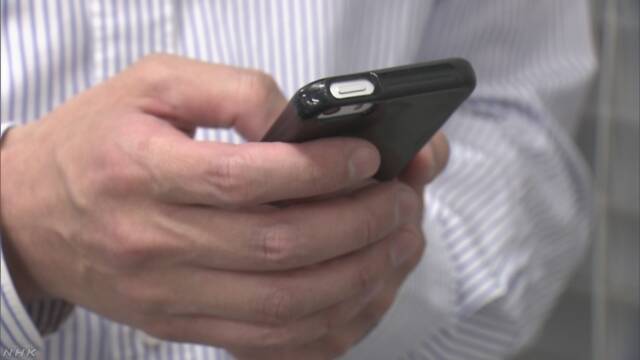Preventing infections through telework and time-staggered commuting Ministry of Health, Labor and Welfare February 23, 11:57
In order to prevent the spread of the new coronavirus in the workplace, the Ministry of Health, Labor and Welfare has set up companies around the country to create an environment where employees with symptoms such as fever can rest with peace of mind, and use telework to spread the infection. Calls to reduce risk.
The Ministry of Health, Labor and Welfare has compiled measures to prevent the spread of infections in the workplace due to the spread of the new coronavirus.
According to this, if fever of 37 ° C for more than 5 minutes continues for more than 4 days, or if you have strong drowsiness or breathlessness, you will be asked to consult the “Returnee and Contact Center” located at a health center. I am.
He is also encouraging the use of teleworking from home to prevent employee infection and the use of staggered commuting to avoid crowds.
Even if telework is used, laws such as the Labor Standards Law are applied and attention must be paid to the management of working hours. Also, when working on a staggered commute, agreements with employees are required and we want them to discuss.
In addition, if employees are to be absent, labor and management should discuss the treatment of wages during absence from work, and seek an environment that allows employees to rest with peace of mind.
The Ministry of Health, Labor and Welfare, through economic organizations such as Keidanren, is urging companies around the country to work on these measures.
Telework Difficult to spread to small and medium enterprises
Telework is a work style that is not restricted to time and place, such as working at home or a shared office without going to work, or using a smartphone while working outside.
A growing number of companies are interested in telework and are starting to work on it.
The Ministry of Internal Affairs and Communications has called on companies and municipalities nationwide to conduct telework during the Tokyo Olympics and Paralympics to reduce congestion during commuting.
The Ministry of Internal Affairs and Communications has implemented a campaign called “Telework Days” in which companies and local governments participate and practice telework for three years, but the number of participating organizations, which was initially 950, has been increasing year by year.
Koshiro aims to participate in 3,000 organizations nationwide and 10% of employees of companies located in Tokyo. Another issue is how to spread telework in small and medium-sized enterprises.
A survey conducted by the Ministry of Land, Infrastructure, Transport and Tourism on the Internet for 36,450 employees, including employees and government employees three years ago, revealed that 14.8%, or 5,393, said they had teleworked.
Looking at the workplaces of the persons surveyed by size, 11% of employees have less than 100 employees, 12.9% have 100 to less than 300 employees, and 15.8% have 300 to less than 1,000 employees. %, More than 1000 people are 25.1%.
Since telework requires securing communication equipment such as smartphones and laptop computers for business use and external offices, it is likely that larger companies with more employees will be more likely to engage in telework.
Companies aiming for complete telework
With the spread of the new coronavirus, some companies have begun to work on teleworking for all employees.
The publisher in Chiyoda-ku, Tokyo, has been doing most of the work for around 100 employees by telework since 17th of this month.
Originally aiming for the Tokyo Olympics and Paralympics, we had been providing notebook computers and introducing systems that allow online attendance management, so we purchased more than 10 notebook computers to improve the environment in a hurry.
Furthermore, for part-time jobs that could only be done in the office, such as reception, customer service, and assistants for office work, all employees were asked to work at home to find out which ones were lacking in human resources, I decided to have the business card data conversion.
Thus, at present, about 90% of employees are working on telework.
Tomoki Iida, who is in charge of managing the editorial department, uses a system that allows all members of the group to be addressed at once, reporting on the contents of work at the beginning and end of work every day, managing progress (shinchoku), I have a meeting using the phone.
Mr. Iida, who lives with the couple and a 5-year-old child, usually commutes to the office in the city center on a packed train, but feels that telework has reduced the risk of infection.
Iida-san said, "I'm more concerned about my children than myself. I feel very comfortable working from home, and I feel that I can choose what I can do now. I do. "
On the other hand, issues have come to light.
Mr. Iida commented on telework, "It's difficult to start a new job because I can't talk to a lot of people and ask for opinions. I also meet with the author of the book and have a meeting or print a galley to confirm I can't do that, so I feel the challenge. "
Technical challenges remain.
Accounting and warehouse inventory management systems are difficult to connect from the outside, and they need to handle mail that arrives in the office.
In the future, we would like to reduce the number of people who go to work by setting up a rotation.
Mr. Fumiyoshi Matsubara, who is in charge of human resources and accounting, said, `` Because employees were flying around bookstores nationwide for sales, I felt that there was a risk of becoming infected or conversely spreading infection, so I immediately started teleworking. I was anxious, but I was often surprised that I was able to do it, but it was the most important to continue the business without affecting the business results. The challenge for the future is to be able to achieve this performance. "

